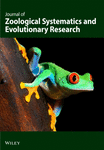Phenotypic variability of quantitative traits in Indian populations of Drosophila kikkawai
Abstract
Drosophila kikkawai, which has colonized the Indian subcontinent in the recent past, exhibits geographical variations for five quantitative traits among eight Indian populations (8.29–32.7?N). Body weight, wing length, thorax length, abdominal bristles and ovariole number exhibit significant clinal variation with increase in latitude, while sternopleural bristles do not demonstrate such a trend. For the female sex, the slope values for body weight (2.25) and wing length (2.40) are higher but they are lower for thorax length (0.64) and ovariole number (0.51 per degree latitude). There is significant sexual dimorphism for the slope values only for body weight and thorax length suggesting simultaneous action of latitudinal selection pressure on these traits. However, the two sexes do not differ statistically in the latitudinal slope values for the wing length. A regression analysis of different traits on body weight implies correlated selection response on wing length and wing/thorax ratio while thorax length corresponds to changes in body size and does not differ in the two sexes. Regression analysis, on the basis of temperature-related climatic variables, evidence significantly higher association between all the five size-related traits and coefficient of variation of mean annual temperature (seasonal thermal amplitude; Tcv), Tmin and relative humidity. Thus, genetic differentiation for quantitative traits in D. kikkawai are due to selective pressure from variable climatic conditions occurring on the Indian subcontinent.




